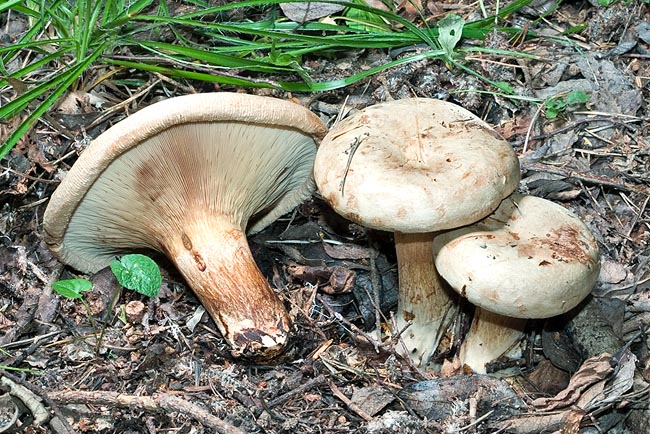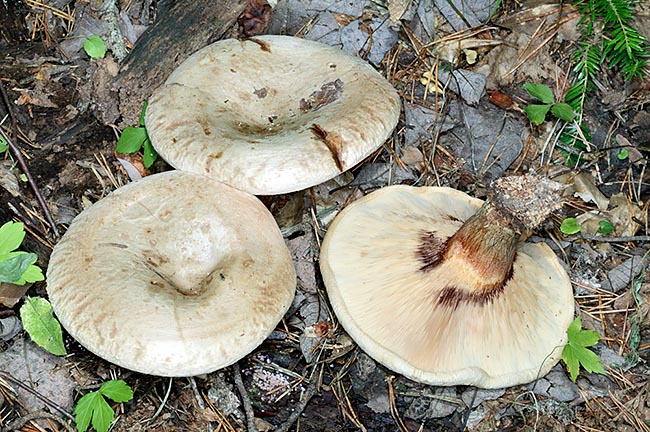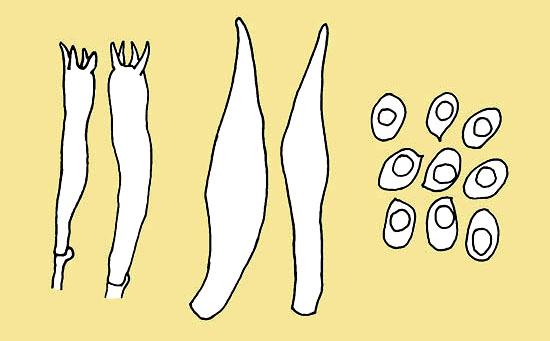
Text © Pierluigi Angeli

English translation by Mario Beltramini

Paxillus involutus cap is initially convex, then flat, finally funnel-shaped © Giuseppe Mazza
Family: Paxillaceae Lotsy, 1907.
Genus: Paxillus Fries, 1836.
Paxillus involutus (Batsch : Fries) Fries, 1838.
The name of the species comes from the Latin “involutus”, involute, inrolled, folded inwards; referred to the margin of the cap.
This species is known also with various popular or dialectal names, in Italy: “Pacsillo accartocciato”, “Pacsillo involuto”; in France: “Paxille enroulé”; in Spain: “Paxil·la de marge involut”, “Paxilo enrollado”, “Orri-ondo hitzaile”; in Germany: “Kahler Krempling”, “Kahle”, “Verkahlende Krempling”; in England: “involute paxillus”, “brown roll-rim”, “common roll-rim”, “poison pax”.
Description of the genus
The genus Paxillus characterizes as having a clitocyboides habitus, if terricolous, pleurotoides or boletoides, if lignicolous. They are fleshy carpophores, of medium-large size; convex to depressed cap with glabrous or tomentose surface, brown to ochraceous-brown to olive beige, turning at times, before reddish then blackish, when rubbed; the strongly inrolled margin; the thick gills, decurrent on the stem, separate easily from the flesh of the cap; the more or less excentric or lateral stem, sub-concolorous to the cap; negligible smell and taste. Ellipsoidal spores, cheilocystidia, pleurocystidia and caulocystidia present. The spores in mass are brown-rust.

Common but toxic even if cooked, can reach the 10 cm of diameter © Giuseppe Mazza
Description of the species
Cap: 4-10 cm, initially convex, then quickly flat and finally even funnel-shaped, margin long time involute then curved downwards, lobed at times; surface finely felty, velvety, tomentose, opaque, sticky in humid weather, olive-brown, tawny brown, ochre-brown, even cinnamon turning brown-reddish when touched.
Hymenium: thick gills, decurrent, arched, forked or anastomosed to the junction of the stem, not too wide, easy to separate from the flesh of the cap, pale-ochre to brown, when manipulated they turn dark brown-tobacco.
Stem: 3-7 x 1-2 cm, cylindrical, attenuated below, curved in proximity to the base, excentric, full, fibrillar, more or less concolorous to the cap but with ochre tonalities then brown, dark brown-reddish when touched.
Flesh: compact, firm then soft, yellow then reddish brown when cut. Smell almost absent, pleasant, bitterish taste.
Habitat: it grows in summer and in autumn, in even crowded groups, in broad leaved as well as of coniferous woods.

Basidia, cistydia and spores of Paxillus involutus © Pierluigi Angeli
Edibility: toxic.
Microscopy: Spores ellipsoidal, ovoid, smooth, guttulous, 6,87-10 × 5-6,8 µm, Qm = 1,42, brown rust in mass. Clavate basidia, tetrasporic, with clamp connections, 37,5-45 × 8,25-10,75 µm. Fusiform cystidia, 65-87,5 × 12,5-16,25 µm.
Remarks. This is a fairly common species growing in whatever type of wood during the autumn. This species, that in the past was considered a toxic only if raw, and that, once cooked, was given as good edible, nowadays, due to several cases of intoxications, is always considered toxic.
It can resemble Paxillus filamentosus (Scopoli) Fries 1838, which however, grows under the alder (Alnus glutinosa Linneo and Alnus incana Linneo), is smaller, has scaly cap and the gills do not stain when touched; the Paxillus rubicundulus Orton 1969, of intermediate size, with auburn fibrils on the cap and the gills staining of reddish.
Synonyms: Agaricus involutus Batsch 1786 (basionym); Omphalia involuta (Batsch) Gray, 1821; Rhymovis involuta (Batsch) Rabenhorst 1844; Agaricus contiguus Bulliard. 1785.
→ For general notions about Fungi please click here.
→ To appreciate the biodiversity of MUSHROOMS please click here.
